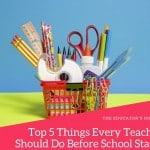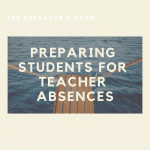The seating plan is often thought of as an important element for student success. From the first day of school, the seating plan is a teacher’s strategy for learning student names, and student names can be the most important piece of information a teacher can gather the first day of school.
For that reason most teachers choose to use an initial seating plan that is alphabetical, but once names are committed to memory, should teachers still use the seating plan?
Scramble the Seating Plan
One year, I experimented with my 9th grade students to change things up by using a different approach that was based on a need to have students be more cooperative and collaborative.
Every day, I would greet the students at the door with the following directions:
“Line up at the front of the room.”
Bags and backpacks tossed along the front wall, I would then ask them to organize themselves, without talking, according to different criteria. This criteria was not academic, and sometimes spontaneous, for example:
- by birthdate;
- by hair color (dark to light);
- by middle name;
- by number of letters in their street address;
- by size order (tallest to smallest);
- by color of their shirt (following a spectrum);
- by the last four letters in their last name.
I would encourage them to silently communicate with each other. Some used a form of sign language; others simply put a letter or number on a piece of paper in order to find their place in line.
Once they were organized, I would check to make sure they were organized correctly (and not trying to stand next to a “buddy”). I would then place the newly organized line into whatever desk arrangement I had chosen. I would feed them into rows, sometimes horizontally and sometimes vertically, across the room. I would place them in a large square forum style set of desks. I would position them in short slanted sets of rows, angled towards the front. By the end of the first week, they were “trained”, and the process took less than 5 minutes.
Organizing groups
When I wanted to set up groups, I would arrange the desks in pods. Then I would create small groups by having them stand in groups based on other criteria, for example:
- by fast food preferences (Taco Bell, McDonalds, Arby’s, Burger King);
- by pet (cat, dog, reptile or bird);
- by favorite color (blue, green, red, yellow);
- by favorite car (Ford, Chevy, VW, Subaru, Toyota):
- by favorite meal (pizza, spaghetti, hamburger, tacos).
Then I would either leave the groups intact or take one member of each group to form new combinations. I could take one category overflowing with students and disperse those members into each of the other categories. These new groups could work for a day’s activity or a long term project. The students never knew who they might be working with that day or week.
Purpose
My purpose for this scramble every period was social. Since our high school was a regional school, the 9th grade was a 60%/40% combination of students who had been together during grades k-8 with new students from any one of 10 area schools. Over the years, I had noticed the isolation of the newer students while familiar friends wanted to work exclusively with each other.
My goal was to have students get to know each other in order to work collaboratively and cooperatively. For weeks during this exercise, they were collaborative and cooperative.
By the end of the second month, however, some of the students expressed weariness of this daily exercise.
“Can’t we sit where we want?” they asked.
I agreed. Frankly, I was running out of criteria!
When they sat in their preferred seats or tables, I did notice that there were interesting social combinations that would not have happened if they had not spent time together as I mixed them up. My goal appeared to have been met.
Vocabulary and the Seating Plan
I did not give up the opening scramble entirely. I would use the format for vocabulary lessons by placing a different definition on each desk, and handing a card with the matching word, one to each student, as they entered the room.
“Match the word to the definition on the desk,” I would say, “…that is your seat for today!”
This form of seating plan kept my social goal intact while letting me know how much vocabulary I needed to review.
Summary of Seating
My adventures in seating worked well most of the time. There were days that I was convinced that students represented by one part of the alphabet were definitely more challenging than other parts or that determining hair color was a more arbitrary decision than I realized.
However, I will counter that no seating plan was ever perfect, and I could still manage the “preferential seating” requirements of PPTs by placing myself or an aide next to students who had that listed. Preferential seating is not always at the front of the room, and I found that most secondary students with that designation would prefer a more confidential location at the back of the room where they can be supported more discreetly.
At the end of the school year, my 9th graders waxed nostalgic about how I had made them scramble every morning.
I obliged them one more time:
“Line up by summer vacation plans… nearest distance from the school to the farthest….and no talking!”
From the stay-cationers to traveling vacationers, they were so cooperative!






Leave a comment